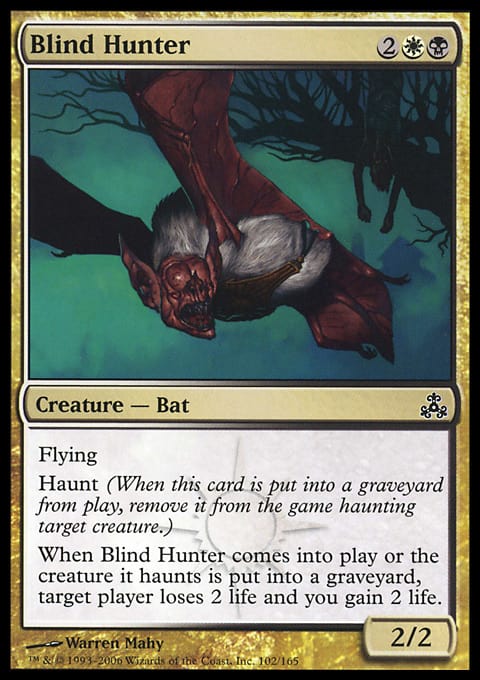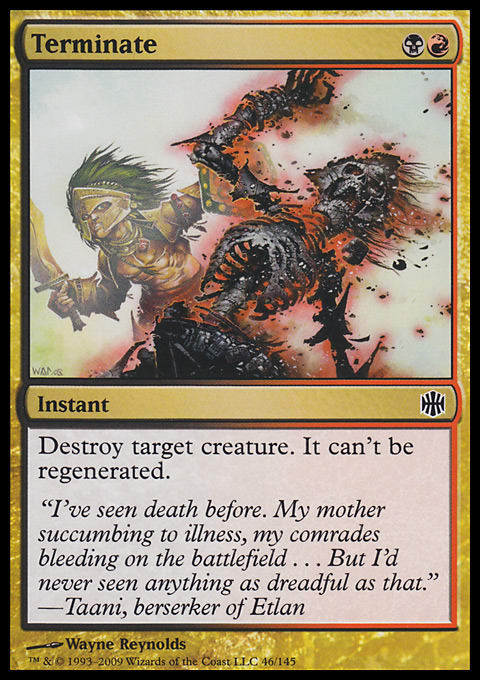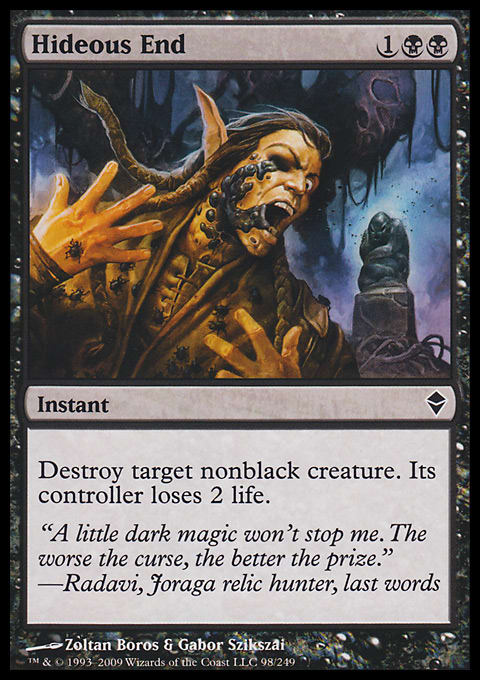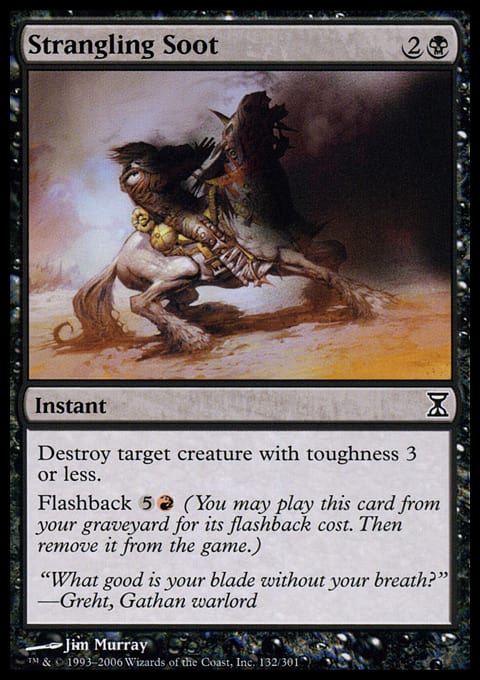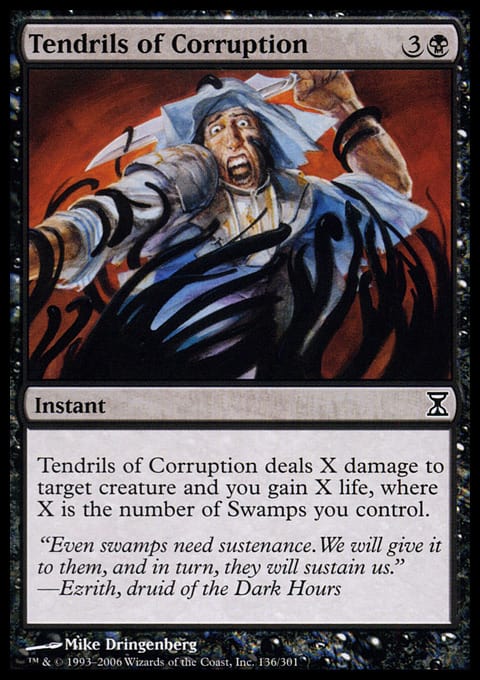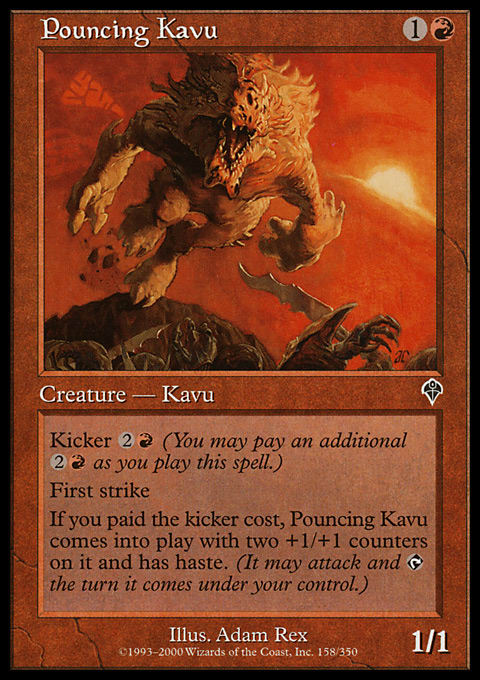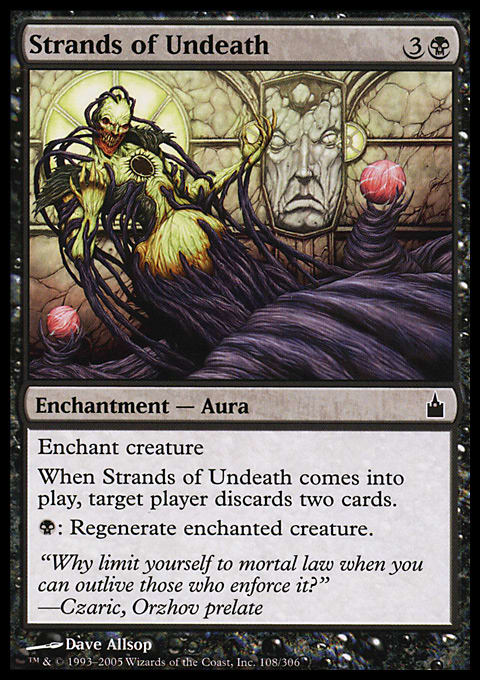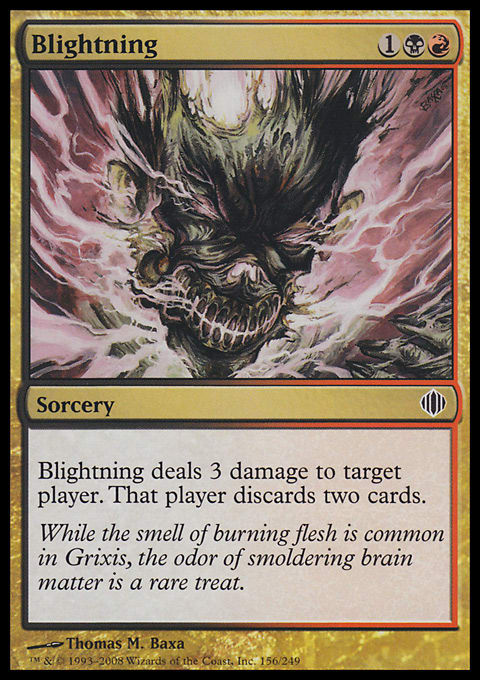There is light at the end of the tunnel. The winding trip through the streets of Ravnica and Cube color pairs is nearing completion. Four guilds stand between us and the completion of the project. Today, we have to make it through a legion of half-dead tax collectors and the people who would eat them for lunch—possibly literally.
Orzhov and Rakdos both thrive on death. It’s just that the way they go about the killing is slightly different. The Orzhov enjoy the slow bleed, eking out every ounce of pain and suffering over the course of a game. If a card trades 1 life of the adversary to fuel its own health, there’s a great chance that card features white and black mana symbols. The Rakdos ain’t got time for that. They want you dead. They’re going to hurl resources at you until you explode. While the end result is the same, it’s important to understand their roles.
Orzhov
Orzhov is traditionally an attrition archetype. Like Golgari, the Syndicate operates on an axis of keeping threats off the table and slowly overwhelming with a pervasive advantage. The distinction between the green pairing and the white are what constitutes the persistence. Golgari uses large monsters in the latter stages of the game to cement victory. The Orzhov don’t have this luxury. Instead, once they have been able to establish a board presence, the W/B deck will often use life-leech effects, like extort, and small, evasive creatures to seal the deal. Because of this, Orzhov tends to play for the very long game, and its primary mode is one built for endurance.
Pay Up
Orzhov cherishes creatures that steal vitality. Blind Hunter and Bloodhunter Bat lead the bloodsucking way thanks to their enters-the-battlefield triggers. The extort trifecta of Syndic of Tithes, Kingpin's Pet, and Basilica Screecher fit this mold as well, and newcomer Scholar of Athreos turns late-game mana-flood into a rotting opponent. The evasive and aggressive creatures find a home in both speeds of white-and-black brews. While Scholar of Athreos is a fine endgame card in the more beatdown-oriented deck, it truly shines in a build that wants to slow the game down. Honorable mentions for tortoise style also include Gray Merchant of Asphodel and Bloodrite Invoker.
Make Way
Like any good Limited pairing featuring black, Orzhov decks crave removal. Perhaps the best two in this color pair are Pillory of the Sleepless and Unmake. Pillory is a win condition on its own that has the added bonus of keeping creatures out of the graveyard (where they can often be retrieved with Gravediggers). Pillory of the Sleepless can also be fetched with Totem-Guide Hartebeest, so having one makes me look out for the other. The Hartebeest also makes other Aura removal—Faith's Fetters, Pacifism, and Dead Weight—far more attractive.
Unmake earns a special mention here since it is vastly better in W/B decks. While stacks featuring either of these colors are theoretically able to cast Unmake in the late game, Orzhov ensures that, if it has three lands, it can exile an offending creature.
Grind It Out
Orzhov holds fast to any form of card advantage that helps keep the game going long. Crippling Fatigue is a higher pick than normal in these decks since the life-loss can be offset in the late game. Cadaver Imp and its ilk are valuable but are rarely returning a game-ending beater. Rather, these cards are used to rebuy some utility creatures that help cement an advantage (say a Chittering Rats). Because this guild lacks access to some of the better, purely offensive creatures, it places a priority on creatures that can generate virtual card advantage. Typhoid Rats and Pharika's Chosen throw a wrench into even the best-laid plans to attack. Seraph of Dawn and Kitsune Blademaster are excellent defensive threats, shutting down a significant number of offensive creatures. Morbid Plunder receives a gold star in this deck due to its backbreaker style of returning two monsters.
Orzhov decks can occupy the anti-beatdown role in Cubes. The color combination’s penchant for making games go long and sucking out life, point by point, lends itself to the long game. These styles of Orzhov are then held in check by other decks that want the grind but having larger threats (Golgari) and decks that can use their cards to generate true, rather than virtual, card advantage (blue decks).
Sample Orzhov Grind ? Cube | Alex Ullman
- Creatures (15)
- 1 Azorius Arrester
- 1 Baleful Eidolon
- 1 Bloodhunter Bat
- 1 Cadaver Imp
- 1 Gravedigger
- 1 Griffin Sentinel
- 1 Kingpin's Pet
- 1 Kitsune Blademaster
- 1 Nyxborn Shieldmate
- 1 Pharika's Chosen
- 1 Ravenous Rats
- 1 Scholar of Athreos
- 1 Seraph of Dawn
- 1 Totem-Guide Hartebeest
- 1 Moriok Replica
- Spells (8)
- 1 Last Gasp
- 1 Unmake
- 1 Crippling Fatigue
- 1 Morbid Plunder
- 1 Pacifism
- 1 Pillory of the Sleepless
- 1 Strands of Undeath
- 1 Leonin Scimitar
- Lands (17)
- 1 Orzhov Basilica
- 8 Plains
- 8 Swamp
Orzhov can also have an aggressive bend in my Cube. In this version, the deck borrows heavily from the strong 2-drops in white that are seeded for Boros and the better beatdown black monsters that are intended for fast Rakdos. The Blind Hunters and Kingpin's Pets in this deck serve as reach, helping to close out the game after the initial damage has been dealt. Because the creatures tend to be undersized, evasion is of the utmost importance.
Sample Orzhov Aggro ? Cube | Alex Ullman
- Creatures (17)
- 1 Akrasan Squire
- 1 Apex Hawks
- 1 Basilica Screecher
- 1 Blind Creeper
- 1 Bloodhunter Bat
- 1 Daring Skyjek
- 1 Doomed Traveler
- 1 Fallen Askari
- 1 Kingpin's Pet
- 1 Kor Skyfisher
- 1 Master of Diversion
- 1 Okiba-Gang Shinobi
- 1 Shrieking Grotesque
- 1 Supply-Line Cranes
- 1 Surrakar Marauder
- 1 Syndic of Tithes
- 1 Warren Pilferers
- Spells (6)
- 1 Blinding Beam
- 1 Doom Blade
- 1 Righteous Blow
- 1 Sign in Blood
- 1 Oblivion Ring
- 1 Flayer Husk
- Lands (17)
- 8 Plains
- 8 Swamp
- 1 Orzhov Guildgate
Rakdos
While Orzhov has found its footing in my Cube, Rakdos, the energetic hedonist that it is, is still bouncing from end to end on the archetype spectrum. This is nothing new. Yet, my inner thrill seeker is currently fine with this dichotomy. Rakdos rewards dedication, whether it be to lightning-fast, all-out aggro or the more plodding destroy-all-monsters builds. The error of the Draft linked above is that neither of the Rakdos drafters picked his or her path early enough. Outside of certain removal spells, the two Rakdos styles have very little overlap. This is in part due to the history of Magic. For years, black and red were laden with fantastic removal at common. It is only recently that these colors have been pushed more toward the full-on beatdown. No wonder this guild is a tad torn.
So, what makes for a good Rakdos-All-Out Aggro?
Smash Face
This deck is all about 2-drops. An ideal curve for Rakdos aggro should spike early and leave nothing expensive to chance. In fact, this is probably the best possible archetype to try for sixteen lands on the regular. The power of these creatures should be equal to or exceed their converted mana costs. Unlike other black guilds, the creatures here are sources of damage first while card economy is a distant second. Cards like Plated Geopede, Keldon Marauders, Blind Creeper, and Dead Reveler stand out in this deck due to their pure offensive power.
Is Something in the Way? Set It on Fire!
Don’t get me wrong—Rakdos decks of all stripes love a Terminate. However, given the option between a simple kill spell and one that burns something, Rakdos aggro will take the latter. Eschewing card advantage means an increased emphasis on ending the game fast. Fireblast and Lightning Bolt are tops, but Hideous End works as well. Searing Blaze is perhaps the best card-advantage removal spell for this deck due to potential damage output.
Sample Rakdos Aggro ? Cube | Alex Ullman
- Creatures (19)
- 1 Ashmouth Hound
- 1 Blind Creeper
- 1 Corpse Hauler
- 1 Dead Reveler
- 1 Fervent Cathar
- 1 Fume Spitter
- 1 Keldon Marauders
- 1 Mogg Fanatic
- 1 Nezumi Cutthroat
- 1 Nyxborn Eidolon
- 1 Plated Geopede
- 1 Rakdos Shred-Freak
- 1 Rubblebelt Maaka
- 1 Skinbrand Goblin
- 1 Skinthinner
- 1 Skirk Marauder
- 1 Vampire Interloper
- 1 Viscera Dragger
- 1 Vulshok Replica
- Spells (5)
- 1 Fireblast
- 1 Hideous End
- 1 Lightning Bolt
- 1 Searing Blaze
- 1 Firebolt
There is another path available to Rakdos. Instead of directing all that sadistic glee at an opponent, it’s aimed at his or her resources—namely creatures. The destroy-all-monsters mode of Rakdos plays up the abundance of great removal in black and red. These are control decks that will win with whatever few creatures it manages to scrounge together. Because, face it, even a 1/1 can take down an adversary if nothing is standing in its path.
Is Something in the way? Blow It Up!
While Terminate is the gold standard for killing creatures dead, Rakdos has plenty of other options. Burn is less important here since the goal is to keep your opponent’s board barren. Removal should be used to keep yourself alive and handle the biggest threat. Strangling Soot is an all-star here, and games go long enough that Tendrils of Corruption isn’t an absurd option.
The Slow, Plodding Path to Victory
Creatures are less important here than in beatdown Rakdos. While you need them to win the game, it is possible to make it by with as few as a dozen, provided you have some solid Disentomb effects like Morgue Burst and Morbid Plunder. Twisted Abomination, Pouncing Kavu, Ill-Tempered Cyclops, and Sightless Ghoul are all feasible win conditions that other decks will probably pass on.
How Many Cards . . . ?
Slow Rakdos is all about resource denial; it’s just that, usually, that resource is time. Blightning, Fill with Fright, and Strands of Undeath all provide the ability for Rakdos to stop threats before there’s any hope for them being cast. Discard does become better in multiples, as it can bury an opponent under a dearth of options. Then, each top-deck summarily dies to removal. The circle of death can be a thing of beauty.
Sample Rakdos Control ? Cube | Alex Ullman
- Creatures (13)
- 1 Baleful Eidolon
- 1 Butcher Ghoul
- 1 Cadaver Imp
- 1 Chittering Rats
- 1 Fireslinger
- 1 Ghitu Slinger
- 1 Mad Prophet
- 1 Pharika's Chosen
- 1 Ravenous Rats
- 1 Retromancer
- 1 Twisted Abomination
- 1 Undead Executioner
- 1 Warren Pilferers
- Spells (10)
- 1 Strangling Soot
- 1 Tendrils of Corruption
- 1 Terminate
- 1 Tragic Slip
- 1 Arc Lightning
- 1 Blightning
- 1 Fill with Fright
- 1 Morgue Burst
- 1 Read the Bones
- 1 Font of Return
- Lands (17)
- 7 Mountain
- 9 Swamp
- 1 Rakdos Carnarium
Two more down; two more to go. Orzhov and Rakdos are similar in that they are both true two-way players, able to take the either side of the active–reactive battle. While Orzhov has many cards that play well in both versions, Rakdos requires fierce dedication and a plan going into the Draft. While one can find himself or herself falling into the clutches of the Church of Deals, if one wants to join the Thrill-Seekers Cult, one will have to carve his or her own path.
Keep slingin’ commons—
-Alex
SpikeBoyM on Magic Online
Check out Common Cause on iTunes!
Discuss Pauper on Twitter using #mtgpauper













